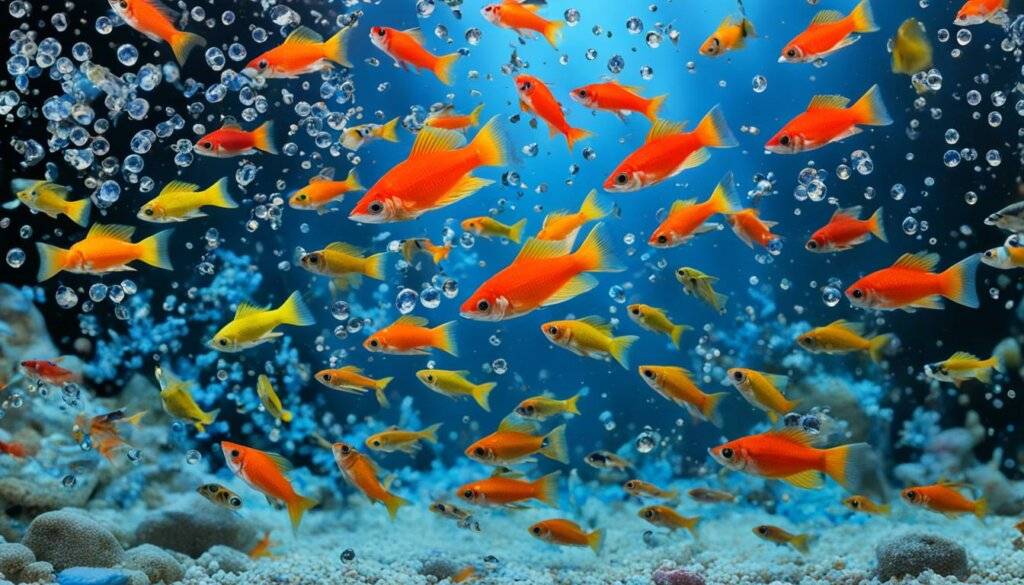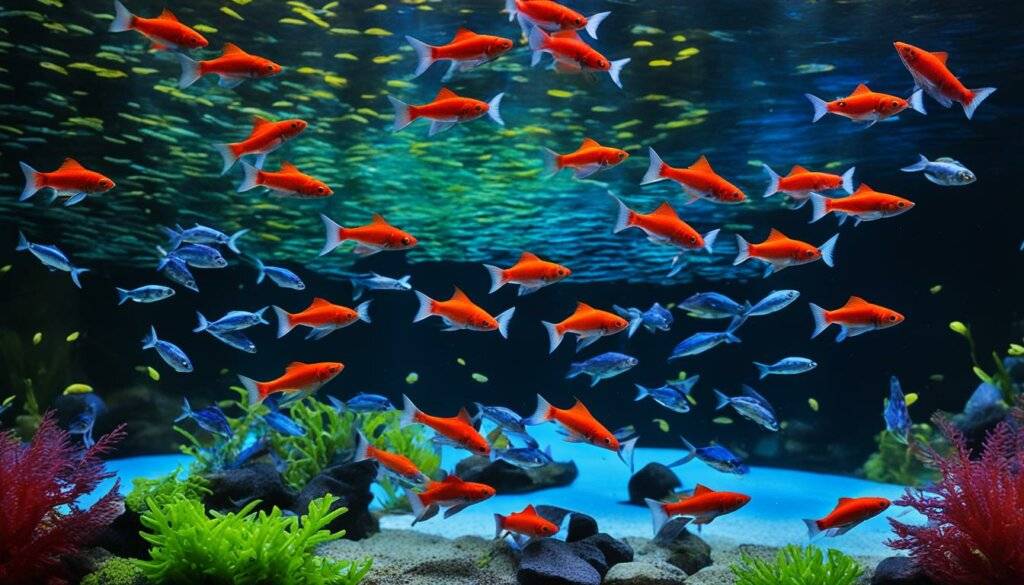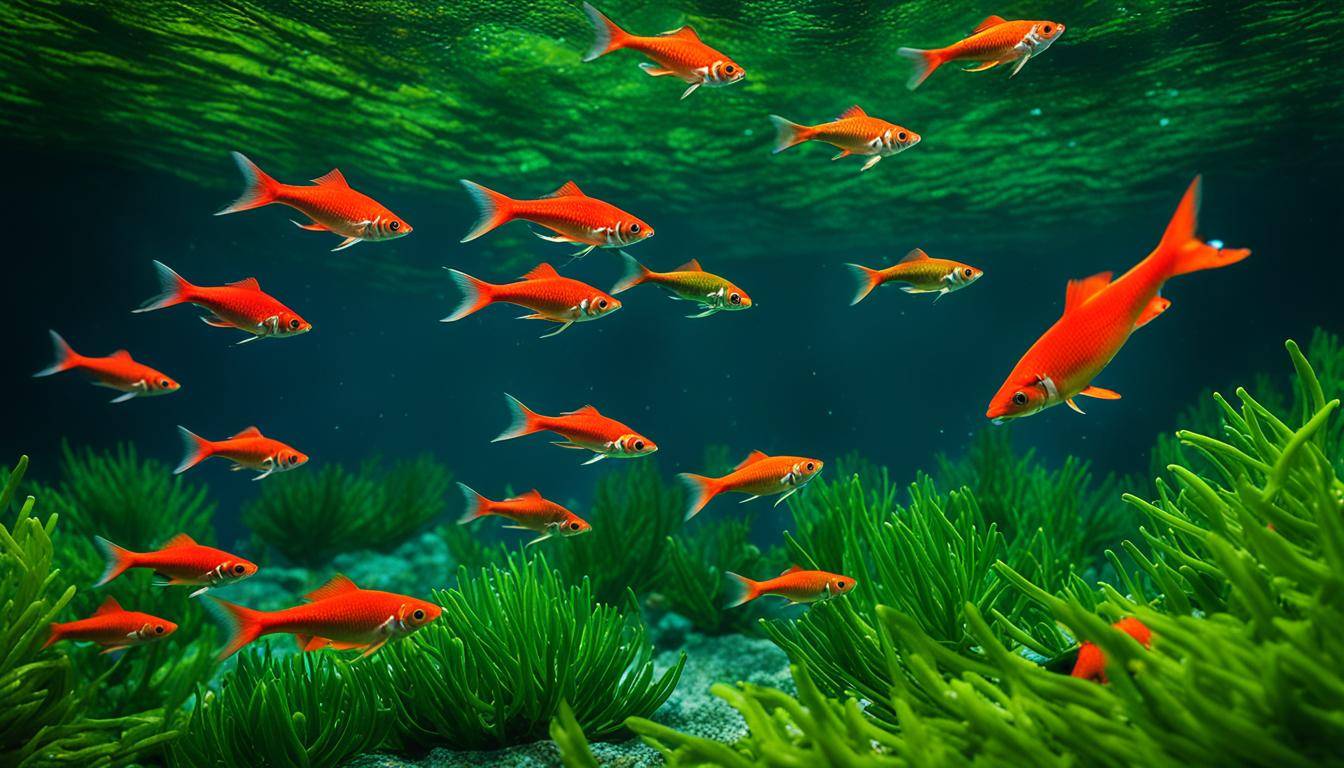Welcome to the vibrant world of ember tetras! These colorful tetras are the perfect addition to your freshwater fish tank, bringing a burst of life and beauty. With their bright orange bodies and lively nature, ember tetras can truly transform your aquarium into a captivating underwater oasis.
Key Takeaways:
- Ember tetras are vibrant and colorful freshwater fish.
- They have bright orange bodies that add a spark of life to your aquarium.
- These small tetras are known for their peaceful nature and are compatible with a variety of tank mates.
- Ember tetras thrive in a well-maintained tank with a suitable environment and a balanced diet.
- By providing the right care and attention, you can enjoy the beauty of ember tetras in your own freshwater tank.
Introduction to Ember Tetra
Welcome to the fascinating world of ember tetras! Also known as Hyphessobrycon amandae, these vibrant fish bring a burst of color to any freshwater aquarium. First discovered in 1987, ember tetras were named after Amanda Behler, the mother of their founder, Heiko Bleher. With their mesmerizing beauty, these fish are commonly referred to as dwarf reds, fire tetras, or simply ember tetras.
If you’re looking to add a splash of vibrancy to your tank, the ember tetra is an excellent choice. Their bright orange bodies and striking black outlines around their eyes make them a captivating species to behold. Don’t be fooled by their small size, as these fish have a spirit that belies their diminutive stature.
Discover the Beauty of Ember Tetras
Ember tetras are a species of tetra that is highly prized by freshwater fish enthusiasts. Their stunning appearance and peaceful nature make them a popular addition to community tanks. Whether you’re a beginner or an experienced hobbyist, these radiant fish are sure to captivate your attention and bring joy to your aquarium.
“The ember tetra’s vibrant colors and tranquil demeanor create a mesmerizing display in any freshwater tank. Their presence adds a touch of elegance and serenity to the aquatic environment.”
Take a closer look at the captivating beauty of ember tetras:
| Key Features of Ember Tetras |
|---|
| Bright Orange Color: The vivid orange hue of ember tetras is truly eye-catching and adds a pop of color to your tank. |
| Small Size: Ember tetras typically grow to about an inch (2.5 cm) in length, making them perfect for tanks of all sizes. |
| Peaceful Nature: These fish are known for their gentle temperament, allowing them to coexist harmoniously with other peaceful tank mates. |
Now that you’ve been introduced to the enchanting world of ember tetras, let’s delve deeper into their natural habitat in the next section.
Natural Habitat of Ember Tetra
Ember tetras are fascinating fish that are believed to thrive in the blackwater tributaries and streams of the lower Amazon basin in Brazil. While their exact range within this region is yet to be fully explored, they have been discovered in central and western areas of Brazil. These picturesque landscapes offer soft substrates and gentle water movements, creating the ideal conditions for ember tetras. The water in these tributaries is stained brown with tannins derived from decomposing organic material, which adds to the mystique of their habitat.
The blackwater tributaries in the lower Amazon basin provide ember tetras with a unique environment characterized by dark, tannin-rich waters. The intricate network of streams and waterways creates a lush and diverse ecosystem, teeming with life. The soft substrates and low water movement mimic the natural conditions found in these tributaries, enhancing the overall well-being of ember tetras.
This serene habitat is not only visually captivating but also offers a variety of natural food sources for ember tetras. Insects, small invertebrates, and organic matter create a balanced ecosystem that supports the health and vitality of these stunning tropical fish.
Conservation Efforts for Blackwater Tributaries
The preservation of blackwater tributaries in the lower Amazon basin is crucial to protect the natural habitat of ember tetras and various other species. These unique ecosystems are vulnerable to deforestation, pollution, and habitat destruction. By supporting conservation organizations and promoting sustainable practices, we can help safeguard these invaluable blackwater systems and ensure the continued existence of ember tetras in their natural environment.
Next, we will explore the mesmerizing appearance of ember tetras and the visual impact they can have on your aquarium.
Appearance of Ember Tetra
The ember tetra is a beautiful fish with striking features that make it a standout in any aquarium. Its bright orange color is one of its most distinctive characteristics, which adds a vibrant touch to your tank. These tetras have black outlines around their eyes, highlighting their delicate and expressive features. Additionally, their fins are slightly darker, creating a delightful contrast against their orange bodies. When fully grown, these small fish reach a size of about an inch (2.5 cm). While both males and females possess the signature bright orange hue, males often exhibit a more bright and intense coloration compared to females.
Ember tetras’ bright orange coloration is not only visually appealing but also serves a practical purpose. In their natural habitat, these fish use their conspicuous coloration to communicate with each other and attract potential mates. The striking hue helps them stand out amongst plants and other aquatic elements, enabling them to form cohesive schools and establish social dynamics within their community.
“The bright orange color of ember tetras is truly captivating. It’s amazing to see how such small fish can bring a burst of color to any aquarium.”
Tank Requirements for Ember Tetra
When it comes to keeping ember tetras, it’s important to provide them with the right tank setup for their optimal health and well-being. Below are some key tank requirements to consider:
Minimum Tank Size: 10 Gallons
Ember tetras are best suited to a tank with a minimum size of 10 gallons. This allows them enough space to swim comfortably and exhibit their natural behavior.
Creating a Blackwater System
To mimic their natural habitat, consider setting up a blackwater system for your ember tetras. This can be achieved by using a heavily planted tank with a darker substrate, such as peat or driftwood. Adding leaves or botanicals, such as Indian almond leaves or Catappa leaves, can help create the desired tannin-stained water.
Low Water Flow
Ember tetras prefer low water flow in their tank. To achieve this, use a filter with adjustable flow settings or consider adding a sponge filter to reduce water movement. Providing a low-flow environment ensures that these small fish can swim easily without being stressed by strong currents.
Protective Barrier to Prevent Suction
Due to their small size, ember tetras are vulnerable to being sucked into filtration systems. To prevent this, it’s essential to provide a protective barrier, such as a sponge or mesh, around the intake of the filter. This barrier will prevent the fish from being drawn into the system and ensure their safety.
Ideal Water Parameters
Maintaining stable water parameters is crucial for the health of your ember tetras. Aim for a temperature range of 72-82°F (22.2-27.8°C) and a pH level between 5.5-7.0. Regular water testing and maintenance will help ensure optimal conditions for your fish.
By providing a suitable tank environment with a 10-gallon capacity, a blackwater system, low water flow, and the right water parameters, you can create an ideal habitat for your ember tetras. Remember to always monitor their health and make any necessary adjustments to ensure they thrive in their aquatic home.
Tank Mates for Ember Tetra
Ember tetras are schooling fish and thrive when kept in large numbers. They are peaceful and can be kept with a variety of tank mates. Some recommended tank mates include other species of tetras, guppies, rasboras, and small peaceful cichlids. Avoid keeping them with aggressive or fin-nipping fish.
Ember tetras, being schooling fish, enjoy the company of their own kind as well as other compatible species in a community tank. The lively and colorful nature of ember tetras makes them an excellent choice for adding energy and vibrancy to your aquarium.
“The best tank mates for ember tetras are other species of tetras that share similar water requirements and temperament. The combination of different tetras can create a visually stunning display of colors and movements, making your tank a focal point of attention.”
Guppies, with their vibrant colors and playful behavior, are another suitable tank mate option for ember tetras. Both species bring visual interest and activity to the tank, creating a lively community environment.
Rasboras are peaceful fish that also thrive in schools, making them great companions for ember tetras. Their small size and calm behavior make them compatible tank mates, and their contrasting colors add to the overall aesthetics of the tank.
Small peaceful cichlids, such as the German blue ram or dwarf cichlids, can also coexist harmoniously with ember tetras in a community tank. These cichlids exhibit less aggressive behavior and will not pose a threat to the tetras.
It’s important to avoid keeping ember tetras with aggressive or fin-nipping fish, as their delicate fins can be easily damaged. Additionally, big and predatory species may intimidate the smaller ember tetras and disrupt their schooling behavior.
Creating a harmonious community tank with ember tetras and their tank mates will not only provide an aesthetically pleasing display but also ensure the well-being and happiness of the fish in your aquarium.
Compatible Tank Mates for Ember Tetra
| Tank Mate | Compatibility |
|---|---|
| Other species of tetras | High |
| Guppies | High |
| Rasboras | High |
| Small peaceful cichlids | Medium |
| Aggressive or fin-nipping fish | Low |
Feeding Ember Tetra
Ember tetras are omnivorous and will gladly devour fish flakes as their staple diet. But to provide them with a well-rounded and high-quality diet, it is crucial to supplement their meals with a variety of nutritious options. Frozen, freeze-dried, and live foods can offer essential nutrients that enhance their vibrant coloration and overall health.
Optimal Diet for Ember Tetra
While fish flakes form the foundation of their diet, introducing live and freeze-dried foods can provide valuable enrichment. Brine shrimp, bloodworms, and insect larvae are excellent choices that emulate their natural prey. These live foods not only offer essential proteins but also simulate their feeding behaviors in the wild, promoting their physical and mental well-being.
Adding a mix of live and freeze-dried foods to their diet is recommended to replicate their natural feeding habits and ensure they receive a nutrient-rich meal.
Live foods can be purchased from reputable fish stores or even cultivated at home, enabling you to provide your Ember tetras with a continuous supply of high-quality sustenance. Culturing brine shrimp or daphnia can be an exciting and cost-effective option that adds a sense of fulfillment to your fishkeeping experience.
A Balanced Approach
While it is essential to offer variety in their diet, it is equally important to maintain a balanced approach. A combination of fish flakes, live foods, and freeze-dried foods can provide the ideal nutrition for your Ember tetras. This diverse range of food sources caters to their omnivorous nature, ensuring they receive the required proteins, vitamins, and minerals for optimal growth and vitality.
Observing your fish’s feeding habits and adjusting their diet accordingly can help fine-tune their nutritional intake, ensuring their individual needs are met. Regularly monitoring their coloration, growth, and behavior provides valuable insights into their overall well-being.
Remember, a high-quality diet leads to healthier and more vibrant Ember tetras, giving you the opportunity to showcase the full beauty and brilliance of these exquisite fish in your aquarium.

-
Save
Breeding Ember Tetra
Ember tetras are relatively easy to breed and can spawn in a display tank under ideal conditions. However, for better control and higher fry survival rates, it is recommended to set up a separate breeding tank. This tank should provide a suitable environment for the egg-scatterers and promote successful breeding.
Setting up the Breeding Tank
The separate breeding tank should have similar water parameters to the main tank. This will help the parent fish adjust easily to their new environment. It is important to equip the breeding tank with appropriate spawning mats, such as fine-leaved plants or artificial spawning mops. These mats will provide a safe surface for the female to scatter her eggs.
Lighting is crucial in the breeding tank. Use dim lighting to simulate the natural habitat of the ember tetra and encourage spawning behavior. A timer can be set to control the lighting schedule, simulating the change from day to night.
Preparing the Parent Fish
Prior to introducing the parent fish into the breeding tank, it is recommended to condition them with a variety of high-quality foods. This will help stimulate their reproductive instincts and ensure they are in optimal breeding condition. Live and frozen foods, such as brine shrimp and bloodworms, can be offered to enhance their nutrition.
The Breeding Process
Once the parent fish are introduced into the breeding tank, they will likely exhibit courtship behaviors, including chasing and flashing their colors. The female will scatter adhesive eggs onto the spawning mats, while the male fertilizes them. These eggs are small and transparent, making them difficult to see without close observation.
Caring for the Eggs and Fry
After spawning, it is important to remove the parent fish from the breeding tank to prevent them from consuming the eggs. The eggs will hatch within 24 to 48 hours, depending on the water temperature. The fry are initially very tiny and will require microscopic food, such as infusoria or commercially available liquid fry food, until they are large enough to consume newly hatched brine shrimp.
Breeding Ember Tetra
| Steps | Description |
|---|---|
| 1 | Set up a separate breeding tank with similar water parameters to the main tank. |
| 2 | Equip the breeding tank with appropriate spawning mats, such as fine-leaved plants or artificial spawning mops. |
| 3 | Control the lighting in the breeding tank to simulate the natural habitat and encourage spawning behavior. |
| 4 | Condition the parent fish with a variety of high-quality foods to stimulate their reproductive instincts. |
| 5 | Introduce the parent fish into the breeding tank and observe courtship behaviors. |
| 6 | Remove the parent fish from the breeding tank after spawning to prevent them from consuming the eggs. |
| 7 | Care for the eggs and fry, providing appropriate food until they are large enough to eat brine shrimp. |
With proper care and attention, you can successfully breed ember tetras in your own separate breeding tank. Observing their spawning behavior and nurturing the eggs and fry will be a rewarding experience for any aquarist.
Lifespan and Care of Ember Tetra
Ember tetras, with their vibrant orange color and peaceful nature, can be a delightful addition to your freshwater aquarium. These hardy fish have an average lifespan of 2-3 years, provided they are kept in optimal conditions.
To ensure the well-being of your ember tetras, it is important to create a suitable environment for them. They are schooling fish, meaning they thrive in larger groups. Therefore, it is recommended to keep them in schools of at least 6-8 individuals. A larger tank size is essential to provide ample swimming space for these active little fish.
| Requirement | Details |
|---|---|
| Tank Size | A minimum tank size of 10 gallons is recommended for a small school of ember tetras. |
| Water Parameters | Ember tetras can tolerate a wide range of water parameters. However, it is important to maintain stable conditions and monitor parameters such as temperature (72-82°F) and pH (5.5-7.0). |
| Tank Mates | Ember tetras are peaceful and can coexist with various other peaceful community fish, such as other tetras, guppies, rasboras, and small cichlids. |
| Feeding | Offer a balanced diet of high-quality fish flakes as the primary food source. Supplement their diet with freeze-dried, frozen, or live foods such as brine shrimp, bloodworms, and insect larvae to ensure optimal nutrition. |
Creating a harmonious and well-maintained aquarium environment will support the overall health and longevity of your ember tetras. Perform regular water changes, provide adequate filtration, and ensure the tank is clean and free from any harmful substances.
Remember, ember tetras are social fish and will thrive when kept in a well-stocked and well-cared-for aquarium. Give them the care and attention they deserve, and you’ll have a stunning display of vibrant color and joyful activity in your home aquatic space.

-
Save
Conclusion
Ember tetras are a vibrant and colorful addition to any freshwater aquarium. Their bright orange bodies bring a spark of life to your tank, creating a visually stunning display. These peaceful fish are well-suited for a community tank and can coexist harmoniously with other species.
By providing the proper tank conditions, nutrition, and care, you can ensure the health and longevity of your ember tetras. Set up a suitable tank with a minimum size of 10 gallons and create a blackwater system to mimic their natural habitat. Maintain stable water parameters with a temperature between 72-82°F (22.2-27.8°C) and a pH between 5.5-7.0.
Ember tetras thrive when kept in larger schools, so consider adding multiple individuals to your tank. Their lifespan of 2-3 years can be extended with proper care and a balanced diet that includes a variety of fish flakes and supplemental live foods. With their vibrant colors and peaceful nature, ember tetras are sure to bring joy to your freshwater aquarium.
